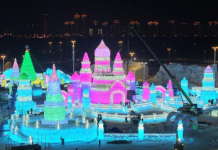Huaian: At the age of 15, Sun Wenqiang first dipped his spoons into the world of cooking under the watchful eye of a senior chef specializing in cooking dishes of Huaian cuisine, which originated from Huaian, Jiangsu Province in east China, but is popular far beyond its birthplace.
Having been a chef for 15 years and tasted numerous palates unique to the places he has come across, Sun, now an executive chef at local restaurant chain Ancient Huaian, believes that the essence of a fine dish lies not only in its taste, but also in its history.
Thanks to its abundant culinary history, Huaian was selected as one of the new cities added to the United Nations Educational, Scientific and Cultural Organization (UNESCO) Creative Cities Network in November.
“Dishes from a city dating back thousands of years should both maintain their cultural and historical features and at the same time embrace modern society. We need to strike a balance,” Sun told Beijing Review.
As a vast country, China currently has eight major cuisine types divided mainly by region. The climate, ingredients, history and dining customs vary greatly from place to place, leading to differences in cooking methods and flavor preferences.
For example, Sichuan cuisine originating from the southwest is famous for its pungently piquant flavor and red color; the southern Guangdong kitchen, with its mild and fresh taste, preserves the food’s natural flavors; while the Shandong gastronomy from the relatively northern part of the country tastes garden-fresh and temperately salty.
Huaian locates on the north-south divide of the country. Its geographical location endows the city with a combination of both northern and southern Chinese cooking and hence the Huaiyang kitchen—a general term for dishes from Huaian and Yangzhou, also known as one of the four major traditional Chinese cuisines. The Huaiyang menu takes fish as its main feature given both aforementioned cities are located not far from the sea in the delta region of the Yangtze River, the longest waterway in Asia and the third longest in the world. Its cooking bears a light and sweet flavor, all the while preserving the ingredients’ original taste. Today, the cuisine boasts over 1,300 dishes.
The city’s gourmet gusto and high gastronomic standards result from its local development since imperial days long gone. As early as the Spring and Autumn Period (770-476 B.C.), a canal was dug around Huaian. The Beijing-Hangzhou Grand Canal, the earliest and longest manmade waterway in the world and a vast channel connecting Beijing and Hangzhou, respectively in the northern and southern sections of China, made Huaian an important water transportation port. In 2014, it was listed as a UNESCO World Heritage Site.
Following the dredging of the canal and the evolution of its water transportation, Huaian flourished as a center for the shipbuilding and waterway management industries. And business was booming. As the city’s cuisine drew inspirations from specialties across the country, it also spread to the more northern parts of China.
– The Daily Mail-Beijing Review News exchange item





